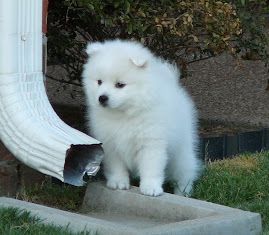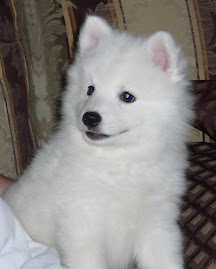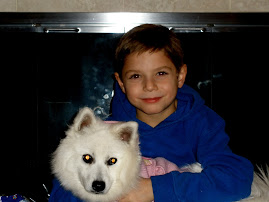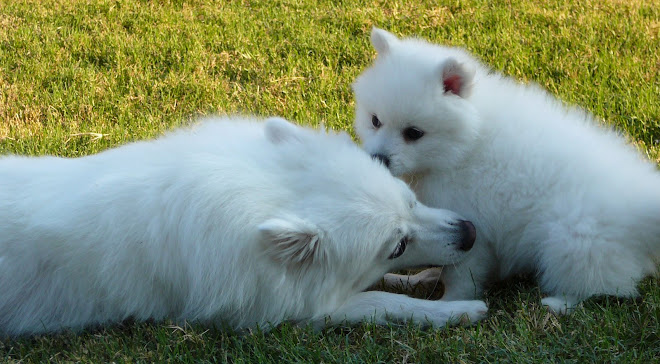 Written November, 2008
Written November, 2008Probably all dog-owners have been told at one time or another that crate-training is a wonderful thing . . . that it not only helps to potty-train your puppy faster, but also that your dog will grow to love the crate and will eventually consider it his/her own personal “den”. Even so, neither Michael nor I could get over the fear that it seemed a little to close to “cruel and unusual” punishment. So, when we decided to bring little 8 week old Geisha home for the first time, we felt confident that keeping her in the back bathroom with a baby gate would suffice. After all, Michael and I have had dogs all of our lives and have never crate trained. Geisha’s bed, food and water bowls would be in the bathroom with her. We were sure it would be fine. Right?
WRONG! Never in my life would I have thought that such an angelic-looking sweetheart could cause so much damage. It didn’t start until she was about 11 weeks old. Michael woke up one morning and went to get Geisha out of the bathroom in order to take her outside for her morning potty break. I was in the kitchen getting the dogs’ breakfast ready. “VALERIE!!!!!!!!”, I hear Michael yell, “COME LOOK AT WHAT SHE HAS DONE!!!!” What our sweet little angel had done was chew a hole through the sheet rock in the wall.
Now Michael and I don’t live in a mansion, by any means. But we are very proud of our home. It was newly built when we got married, and we were very blessed to get it. We spent many hours and dollars decorating and painting the house to make it suit our personalities. So, when Geisha, the puppy who stole our hearts from the very first moment we saw her, proceeded to damage something we had put so much energy into, we were just a little upset. In the following months, when our precious Geisha chewed through more walls, cabinets, carpeting, window sills and door frames, we were A LOT upset. It took Geisha about a year to get out of her “chewing” phase. And now that she is about 2 ½ years old, she has full roam of the house, even when we are not at home. She has long-since proven that she is trust-worthy. Experience has now taught us that Geisha’s need to chew grew with each item destroyed . . . A vicious cycle.
When the time came for us to bring Sami home, there was no question in either of our minds. Oh yes, we were going to crate-train. Michael bought the second biggest wire-crate that Wal-Mart had to offer. We brought home our little 6 pound, 8 week old puppy and introduced him to his new “bedroom”. His bed was kept in the crate, as well as his food and water bowls, which were fastened to the sides so he couldn’t tip them over. As it turned out, all of the crate-training advocates actually knew what they were talking about. Sami was potty-trained in about ½ the time as Geisha (though some of that may be contributed to a change in our potty-training methods). More importantly, Sami is now about 1 ½ years old and we have never had a chewing problem with him. In conjunction with our “vicious cycle” theory, we feel that since he never had the opportunity to learn how much fun chewing up our home and furniture could be, he never developed that vigorous need for chewing. As a result, he seemed to come through his “chewing” phase much quicker. We are training Ju-Ju in this same way, and she is also much less of a chewer than Geisha was.
In summary, please crate-train! I promise it will make for a much happier home life!
A Few Basic Crate Training Rules (as given by the Delaware Puppy Rescue Group)
- A crate should never be used as punishment.
- A puppy should never be confined to a crate for longer than 3 or 4 hours when you are not home.
- If you purchase a large crate that will fit your puppy when it is full grown, then you should partition off part of it so that puppy doesn't have too much room. If the crate is too large, puppy will use it to go potty.
- Move the crate from room to room with you and allow puppy to sleep in it's crate in your bedroom at night. This gives them a sense of security and they will settle down much more quickly knowing you are right there.
A key ingredient in crate training is to make it fun for the puppy. Do this by putting some treats in the crate and letting puppy find them. Toss the treat into the crate and when puppy goes in to get it, praise GOOD DOG....GOOD PUPPY! Once in a while when puppy goes into crate to retrieve the treat, close the door for a few minutes. If puppy is nice and quiet say GOOD PUPPY. However, if puppy is making a ruckus - IGNORE. When puppy settles down, say GOOD PUPPY and then open the crate door.
Remember...make this fun. It should never be a form of punishment!
Crate training is a wonderful way to help you housebreak your puppy. Puppies will avoid using their "den" as a place to go potty. Immediately upon taking puppy out of the crate bring it outside to relieve itself.....DO NOT stop to play with it first! Once puppy has relieved itself outside give lots of praise! Praise so much that your neighbors will think you have lost your mind!!! As soon as you feel confident that puppy is "empty" you can then return to the house and have some play time or whatever.
Remember....puppies have next to no bladder or bowel control. What goes in one end very quickly comes out the other. So when you feed them, immediately take them out to go potty and when they go LOTS OF PRAISE. When you take them out to potty use the same phrase each time. Something like "potty" or "hurry" works well.
As I mentioned above, you cannot restrict a puppy to a crate for more than 3 or 4 hours at a time when you are not with them. If you work away from home all day (as most people do) you could try to enlist a neighbor to come and take puppy out several times a day. There are also pet walkers you could hire to do this.
Working people should consider using an X-Pen in addition to a crate for during the day. The X-Pen can be set up in say the kitchen with the crate (with door open) in one corner of the pen. If no one will be taking puppy out during the day you will have to "paper train" in part of the X-Pen. Puppy then will have a larger area to exercise in and can still use his/her crate for taking naps.
Puppies should not be trusted to have free run of your home. There are too many things they can get into -- things that can hurt them and destroy your property at the same time. When you are busy you can either crate the puppy or tether it's leash to you so that you are constantly aware of what puppy is doing. Use constant commands and phrases such as "settle down" or "easy" when puppy is acting too wild.
If you are busy and decided to crate puppy, try putting the crate in the same room with you. That way puppy doesn't feel like it's being punished and can keep an eye on you at the same time. At bedtime put puppy's crate in the bedroom with you. Puppies that are allowed to sleep with their humans tend to settle down much more quickly. Plus...when puppy needs to go potty in the middle of the night you will be able to hear their call.
Crate training has many additional benefits. If you plan on taking your puppy/dog with you on vacations being able to tell a hotel/motel innkeeper that your dog will be in it's crate when you are not in the room is a big plus!
By: Helen T. Redlus












